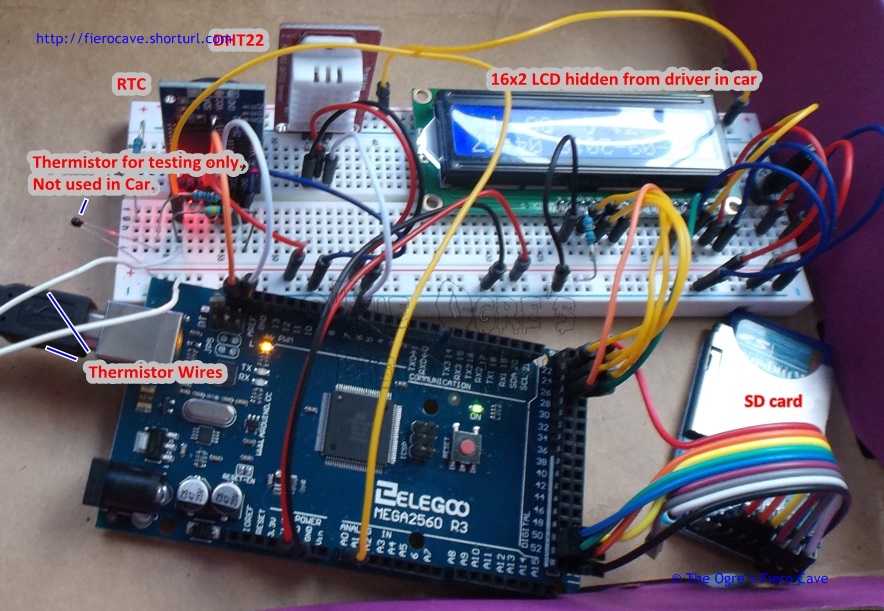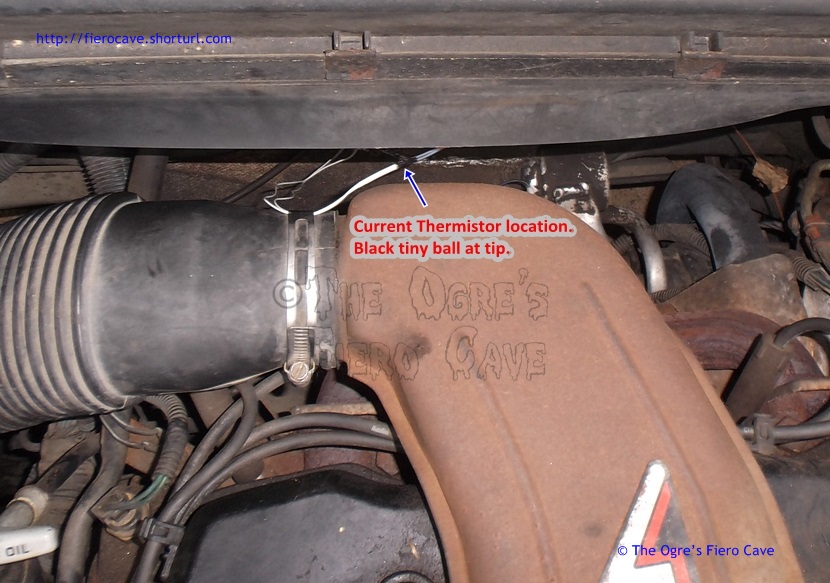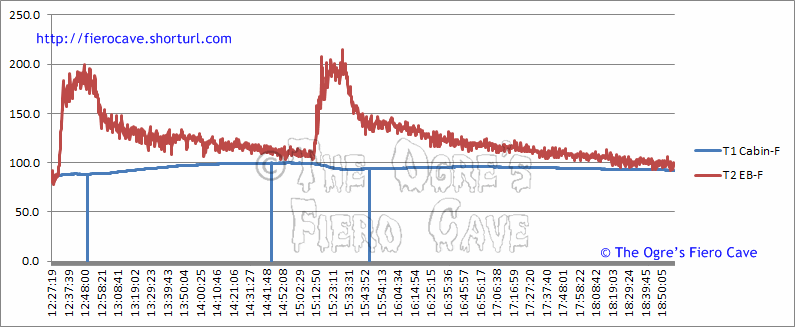
 
     |
| Fiero Engine bay vs Heat. (Page 1/3) |

|
theogre
|
SEP 11, 11:58 PM
|
|
Many still think the Fiero Engine Bay is always hot and needs extra cooling every time the car is running...
Others think gets hot but Vents cool the car when moving.
Winner is
Vents cools when moving. A lot of cooling too.
But when parked after running the Temperature climbs fast even with rainy weather today.
IOW If you think you need fan(s) under the vents etc when running... Most fans are blocking air flow when off and parked car engine bay bakes everything at higher temps and longer time.Click to show
I did some testing for this 15+ years ago but limited probes and no cheap way to record thermocouples etc.
Then someone bought me an "off brand" Arduino starting kit a couple months ago and while good, no much to do with most modules for me. (Is funny that Arduino forums label most others as counterfeit or worse but claim the product is "open source...")
But Did come w/ some things like Real Time Clock then add more temperature and other options.
So made a basic data logger and tested temp in the cabin and near the DIS Duke air cleaner.
Figure that is above ~1/2 of the exhaust and only area wires reach in a hurry.


The thermistor size is less than a grain of most types of rice and hard to see in second image. Picture looking down and Thermistor is in front of the neck.
Short results of a quick test?
Weather at start and next couple of hours: ~71°F
Car moving, bay temp stays ~ 75°F.
Slow down to a crawl to find parking? ~ 88°F
When park at school... fast rise started at 96° and went up to 199° in ~ 17 minutes then slowly cooled off.
When left and car is moving again Temp drops to 105-115° because engine is still warm an hour later.
Got home and parked the peak was 192°F then cool down fully for 3+ hours.
I'll add other temp readings when I get time. Maybe I'll add air flow at one of the vents but cost money and don't see another use. (Yes can try using a fan as a input but then no-one believe them without reliable calibration.) Temp sensors are cheap and even when not, can use in a lot of other places.
Want to add speed so I don't have to remember when temp rises/falls in Excel. I could tap 5v speed in the ECM and I can program other things but don't know C well and ArduinoIDE is a joke editor but others have their own issues so takes time to learn them.
Search Google etc can help but many answers no longer exist or are complete junk making more problems like many YT "experts."------------------
Dr. Ian Malcolm: Yeah, but your scientists were so preoccupied with whether or not they could, they didn't stop to think if they should.
(Jurassic Park)
The Ogre's Fiero Cave
|
|

|
BadNewsBrendan
|
SEP 12, 01:52 PM
|
|
|
Awesome project! Might have just found a use for my arduino and thermocouples I have laying around from college. Come to think of it I think I have a thermostat code saved somewhere...
|
|

|
sourmash
|
SEP 12, 03:01 PM
|
|
|
The air through the vents when moving, does it go upwards out the top of the deck?
|
|

|
Patrick
|
SEP 12, 03:28 PM
|
|
| quote | Originally posted by sourmash:
The air through the vents when moving, does it go upwards out the top of the deck?
|
|
Heat rises... no point trying to fight it. 
|
|

|
theogre
|
SEP 12, 09:16 PM
|
|
Well I mess up the results some...
The RTC was reset to compile time and I did't fix the time stamp.
Fix the clock and capture data again today since I had another meeting at same place...
I still stand by the winner because Exhaust parts run 400-600°F and the thermistor was right above exhaust manifold with nothing to protect it.
So Driving the car had/have the peak temps but stayed under 200°F
Today...
Starting today at ~85°F and mostly cloudy.
Engine warm fast as usual but bay temps stayed in the rage of 150° to 195°F if the car is moving between 30 to 70MPH. Slower speed seems to like better cooling or power train just runs a bit hotter at 65-70MPG. Likely the later because TCC valve is bad and unplugged.
When shutdown at school, the temp kept dropping to ~107°
Drive home average peak was ~190°
Quick Excel Chart...

3 dropouts in T1 cabin is DHT22 not ready and I didn't remove those rows.
T2 EB is Engine Bay temps but Signals from a thermistor w/o shielded leads get a lot of noise is why you see a line like above.
I'm using 100kΩ Thermistor rated to 300°F (the one on the breadboard is only 10kΩ.)
I have several K type Thermocouples and MAX31856 Thermocouple Interface. The better chip has cold side compensation and Linearization built in to stay accurate w/o math processing by whatever. (Other older chips likely max31855 only have cold side.) For my quick data log test I didn't bother to install max module yet. Don't want to many things that could move around taking the kit in/out of car. worse this and SD are SPI and daisy chain modules are a big target of problems w/o having everything screwed down.
Side Note:
If anyone is writing data logs for anything. Can ignore many twits how to format the data...
I been using and programing data log programs/devices for decades and Most YT and other "experts" have no clue on how to use comma and other delimiters, format headers, etc. then confuse everyone else. Even the file name matters because many back end programs auto format the output file or not depending on 3 char extension.
|
|

|
theogre
|
SEP 12, 09:54 PM
|
|
| quote | Originally posted by sourmash:
The air through the vents when moving, does it go upwards out the top of the deck? |
|
| quote | Originally posted by Patrick:
Heat rises... no point trying to fight it.  |
|
Only 100% True when the car is parked.
Air flow around/under the Fiero when car moving can do very odd things like ~1/2 of air can roll backward on the rear deck. If you parked under a tree, leaves and more can get trap behind rear window and in the vents. That is a pain in the a--- for many.
You need one that sees speed and flow direction. Most only sees speed...
You can get very small MAF type units for arduino etc but can't tell direction.
other mechanical units I've seen are made for Weather stations and are too big and wrong type for this use.
Some amp "chips"/modules have ±X amps 0-5V output w/ 0amps = 2.5v.
Would need same setup or second output, in output data or pin output, to show direction.
|
|

|
ZCR1
|
SEP 14, 04:13 PM
|
|
|
The notch area behind the rear window creates a low pressure area which pulls the air up through the vents at speed. The underside and wheel wells of our cars are not quite like race cars which are designed to evacuate air and "suck" the car to the road. So, if you modify the body or underside to create more downforce by evacuating the air, creating low pressure, you can actually equalize the pressure above the vents and trap more heat in the engine bay. I think a few carefully placed barometers would give a much better picture of what is happening rather than monitoring temps which are influenced by way too many variables.
|
|

|
cvxjet
|
SEP 14, 06:04 PM
|
|
I grew up around aircraft....So I know something about aerodynamics (At least enough to be dangerous!)......What Ogre said about air doing odd things is true...The decklid air rolls backwards at certain speeds....And the spoiler helps lower the drag coefficient by keeping the air running straight off the deck.
My 73 mach 1 would float at 65-75....even though I had lowered the front by an inch.....ALL the air gets rammed under the hood- and then has nowhere to go...Hood area is 3000 square inches so 1/10 of PSI creates 300 lbs of lift! So I made an airdam that is open in front of radiator BELOW the bumper, with the sides angled back a bit, and a reverse angle lip at the bottom....and then I BLOCKED off the upper grill completely...The only air into the engine compartment was through the air dam under the bumper in the center.
Had that car up to 90+ passing 3 semis on H97 above Weed, CA....Solid as a rock! And no cooling problems (Vacuum behind radiator works better than high pressure in front (And behind) radiator!
As far as under-lid heat....The dang exhaust just kills the compartment.......Make sure your heat shields are good, and I actually removed the grates from under my vents to get better air flow.....But I never park under a tree- Ever!
|
|

|
theogre
|
SEP 14, 07:55 PM
|
|
| quote | Originally posted by ZCR1:
The notch area behind the rear window creates a low pressure area which pulls the air up through the vents at speed. The underside and wheel wells of our cars are not quite like race cars which are designed to evacuate air and "suck" the car to the road. So, if you modify the body or underside to create more downforce by evacuating the air, creating low pressure, you can actually equalize the pressure above the vents and trap more heat in the engine bay. I think a few carefully placed barometers would give a much better picture of what is happening rather than monitoring temps which are influenced by way too many variables. |
|
Funny that you mention this... Because found my spare MAP and plug and wired to the kit yesterday. Tested some and AD input for arduino makes it quite sensitive. I'm not calibrating this very much but can tell if there is a vacuum.
I check w/ a better version of real Mighty Vac hand pump w/ a gauge and even a small faction of pulling handle you see the number change.
I have to make longer wires etc to put all in the car again.
They make other "chips" for this but cost money to buy and spend too much already.
Most are doing same job w/ same 1 bar limit as MAP but have I2C etc built into them like modules w/ MPL3115A2.
Even if there's little vacuum... Constant wind there will move air thru the vents. Air flow under the car can push up or suck down air in the bay too.
These can't tell you what direction unless maybe you have several running at same time.
Every engine bay is hot when driven then open the hood so most just think they are hot all time time and guess hotter then real as well. Simple measurements tell this is not the case but most can't understand. I have more temperature probes but not in hurry to use them.
I didn't cover that even on very cloudy the cabin temp is ~100°F parked at school. Less later because lower sun and building at home. I got DHT22 because has a higher working limits to test cabin temp on a clear day and next summer. Earlier quick tests w/ meat thermometers I saw 166°F on a clear day even tho weather was ~60-70°.
|
|

|
Formula Owner
|
SEP 17, 10:31 AM
|
|
| quote | Originally posted by ZCR1:
The notch area behind the rear window creates a low pressure area which pulls the air up through the vents at speed. The underside and wheel wells of our cars are not quite like race cars which are designed to evacuate air and "suck" the car to the road. So, if you modify the body or underside to create more downforce by evacuating the air, creating low pressure, you can actually equalize the pressure above the vents and trap more heat in the engine bay. I think a few carefully placed barometers would give a much better picture of what is happening rather than monitoring temps which are influenced by way too many variables. |
|
I'm thinking that even just lowering a car can have an effect. I just ran the Georgia Fiero Club's RFTH event this weekend. A couple of guys had some temperature problems. Not bad problems. Not overheating, but still, they were running a little hot. Some were running with the dryer connector disconnected so they could run the cooling fan without running the compressor. My bone stock Formula, with stock wheels and stock sized tires, was rock solid, temperature-wise. I'm not sure that the others were lowered, but that might explain why they were running hotter than I was. Do 88's have better airflow? I had the only 88 V6 on the run.[This message has been edited by Formula Owner (edited 09-17-2018).]
|
|
    
  |
|















